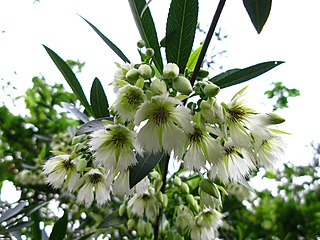
Myrtaceae, the myrtle family, is a family of dicotyledonous plants placed within the order Myrtales. Myrtle, pōhutukawa, bay rum tree, clove, guava, acca (feijoa), allspice, and eucalyptus are some notable members of this group. All species are woody, contain essential oils, and have flower parts in multiples of four or five. The leaves are evergreen, alternate to mostly opposite, simple, and usually entire. The flowers have a base number of five petals, though in several genera, the petals are minute or absent. The stamens are usually very conspicuous, brightly coloured, and numerous.

Elaeocarpus is a genus of nearly five hundred species of flowering plants in the family Elaeocarpaceae native to the Western Indian Ocean, Tropical and Subtropical Asia, and the Pacific. Plants in the genus Elaeocarpus are trees or shrubs with simple leaves, flowers with four or five petals usually, and usually blue fruit.

Coprosma is a genus of flowering plants in the family Rubiaceae. It is found in New Zealand, Hawaiian Islands, Borneo, Java, New Guinea, islands of the Pacific Ocean to Australia and the Juan Fernández Islands.

Pimelea, commonly known as rice flowers, is a genus of plants belonging to the family Thymelaeaceae. There are about 150 species, including 110 in Australia and 36 in New Zealand.

Olearia, most commonly known as daisy-bush, is a genus of flowering plants belonging to the family Asteraceae, the largest of the flowering plant families in the world. Olearia are found in Australia, New Guinea and New Zealand. The genus includes herbaceous plants, shrubs and small trees. The latter are unusual among the Asteraceae and are called tree daisies in New Zealand. All bear the familiar daisy-like composite flowerheads in white, pink, mauve or purple.

Carmichaelia is a genus of 24 plant species belonging to Fabaceae, the legume family. All but one species are native to New Zealand; the exception, Carmichaelia exsul, is native to Lord Howe Island and presumably dispersed there from New Zealand.

Celmisia is a genus of perennial herbs or subshrubs, in the family Asteraceae. Most of the species are endemic to New Zealand; several others are endemic to Australia.

Brachyglottis is a genus of flowering plants in the family Asteraceae. The genus was erected on November 29, 1775, by Johann Reinhold Forster and Georg Forster. The name was derived from the Greek brachus ("short") and glottis a reference to the size of the ray florets.

Melicytus is a genus of flowering plants in the family Violaceae. Hymenanthera is a synonym. It includes 19 species native to Australia, New Zealand, and the southwestern Pacific.

Xanthostemon is a genus of plants in the myrtle family Myrtaceae, first described in 1857 by the German–born Australian botanist Ferdinand von Mueller. The genus is distributed across Malesia, Papuasia and northern Australia. The genera Pleurocalyptus and Purpureostemon from New Caledonia are morphologically close to Xanthostemon.

Scleranthus, the knawels, are a genus of herbaceous plants in the family Caryophyllaceae. It includes 12 species native to Europe, Siberia, western Asia, north Africa, Ethiopia, New Guinea, and Australia.

Gahnia is a genus of sedges native to China, Southeast Asia, New Guinea, Australia, New Zealand and a number of Pacific Islands. The common name is due to the toothed margins. It often forms tussocks.

Astelia is a genus of flowering plants in the recently named family Asteliaceae. They are rhizomatous tufted perennials native to various islands in the Pacific, Indian, and South Atlantic Oceans, as well as to Australia and to the southernmost tip of South America. A significant number of the known species are endemic to New Zealand. The species generally grow in forests, swamps and amongst low alpine vegetation; occasionally they are epiphytic.

Sannantha is a genus of flowering plants in the family Myrtaceae that are native to Australia and New Caledonia. Plants in the genus Sannantha are shrubs or trees with leaves arranged in opposite pairs, flowers usually arranged in small groups, the peduncles often 1.5–2 times as long as the pedicels and with seven to fourteen stamens. The fruit is a thin-walled capsule containing flattened, D-shaped seeds. Some species of Sannantha were previously included in the genus Babingtonia.

Zanthoxyloideae is a subfamily of the family Rutaceae.

Scandia is a genus of flowering plants belonging to the family Apiaceae. It is also in tribe Aciphylleae, with plants, Gingidia Dawson and Lignocarpa Dawson, with all three genera being native to New Zealand. They are scrambling shrubs with white flowers.
















